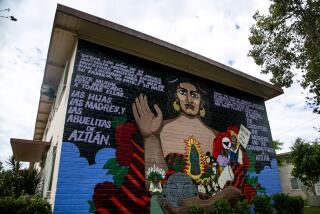Once Just a Line in the Sand, the Border Now Shapes Lives
- Share via
If St. Joseph’s Hospital had been built just a few feet farther south, or if it had been just a little bit larger, Carlos Velez-Ibanez might have been born directly atop the U.S.-Mexico border. Not that anyone would have noticed, or cared. In 1936, the border was just a mark on the map that few paid much attention to. In some places, in fact, the locals weren’t even sure where the border was.
Luz Ibanez Maxemin was among those who paid little mind to such arbitrary lines in the desert sand, driving regularly from her home in Tucson to visit relatives in Sonora. But on one of the return trips she unexpectedly went into labor, forcing her husband, Adalberto, to stop at the first hospital they saw.
“I was literally born right next to the cyclone fence,” says Velez-Ibanez. So the border was born into Velez-Ibanez just as surely as he was born unto the border. And it’s that birthright that makes the anthropologist’s latest book, “Border Visions: Mexican Cultures of the Southwest United States” (University of Arizona Press), as important as it was perhaps inevitable--important in that it belies many myths and assuages many fears at the very time when myths and fears have come to influence the political debates about the border.
*
Velez-Ibanez split his childhood between Tucson and Magdalena, Sonora, a small pueblo about 50 miles south of the border on Mexico’s Highway 15. Aside from becoming bilingual and bicultural at a young age, he was also binational. And that experience taught him that the international boundary was more a mental and psychological barrier than it was a physical or geographic one.
“It’s a political border,” he says. “But it’s also a psychic border. And nationalism on both sides of the border is part of the mental block. Mexicans are very nationalistic because of the border. They wouldn’t be so nationalistic if the border wasn’t there.”
And Americans wouldn’t be so wedded to their nationalism if that border wasn’t there, he says. In other words, without a border there would be very few border problems.
OK, Velez-Ibanez concedes, that may be a simplistic explanation. But it happens to be historically accurate.
For hundreds of years before NAFTA, for example, free trade flourished across the Rio Grande and workers migrated north to fill the mines, ranches and, later, factories of the region with little concern about citizenship, much less the Immigration and Naturalization Service. But the border changed all that, especially during the Great Depression.
By then Mexicans had become commodities, economic tools to be used, then discarded. Double-wage structures, which paid Mexicans half what whites made for the same work, took root and other abuses followed.
*
On a hot summer day the week after graduation, there are more squirrels than students on the sprawling UC Riverside campus. Yet Carlos G. Velez-Ibanez, 59, dean of the College of Humanities, Arts and Social Sciences, is dressed sharply if uncomfortably in a dark blue suit and tie. Tall, thin and ramrod straight, his neat mustache and close-cropped hair speckled with gray, he looks more like a conservative banker or lawyer than an activist who marched for Chicano rights.
At first his spacious office seems to add to the illusion. But a closer look reveals a collection of Latin American artwork worthy of a museum, from brightly painted clay vases and sculpted wood pieces to a large print of Diego Rivera’s “Flower Vendor” and a framed detail from Jose Antonio Burciaga’s “Mythology of Maize,” the same image that graces the cover of “Border Visions.”
The office is new, Velez-Ibanez explains. Modesty prevents him from adding that this office was hard-earned. It took four degrees, three books, countless reviews and studies and two decades of teaching to get him here.
Still, he hasn’t lost his professorial manner. Even in an intimate setting, he answers questions in a clear, booming voice that could easily reach the back of even the biggest lecture halls.
The book, then, is much like its author: serious and formal at first glance, but fueled by a culture and passion that reveal themselves over time. His previous writings were mostly dense academic tracts about the culture and politics of urban Mexico or journal articles with unwieldy titles such as “The Anthropological Analysis of Schooling Processes Among U.S. Mexicans, Puerto Ricans and Cubans: A Comparative, Distributive, and Case Study Approach.”
But with “Border Visions,” Velez-Ibanez was hoping to reach a broader audience. And he appears to have succeeded. January’s modest first printing has sold well, and officials at the University of Arizona Press say a second press run is likely.
Written in the detached manner of a social scientist but researched with the emotion of a political activist, the book focuses anthropology, history and personal anecdotes on a subject everyone knows but few understand.
“I don’t think anyone has written a book quite like it,” says James Diego Vigil, a professor of anthropology at UCLA and author of several books on Mexican American culture, including “From Indians to Chicanos,” first published in 1984 (Waveland).
“No one that I know of has combined both aspects . . . the research skills, the methodology and the personal experience. He covers a lot of history.”
What Velez-Ibanez calls the book’s “continuing search for space and place” covers several centuries, from pre-Columbian times to the present. As the author explains, the “bumping” among Native American, Spanish, Mexican and Mesoamerican populations increased as populations and ideas moved north. But rather than becoming completely assimilated into the dominant culture of the region, many Mexicans and Mexican Americans have maintained their heritage with the help of strong family ties that extend on both sides of the border.
And by exploring those issues, Velez-Iban~ez sheds a unique light on complex and emotional issues such as immigration, the North American Free Trade Agreement, class conflicts and racism.
“I wrote the book because the tale hadn’t been told,” Velez-Iban~ez says. “It is my attempt to tell the tale of a population generating cultural patterns and behaviors to survive in a dignified manner.
“This book is an attempt to deal with what’s never been told about the Mexican population of the Southwest--and its forebears and the whys and the wheres and the hows of that whole population.”
And though the pages drip with irony and injustice, for the most part this is a tale of triumph. In it, families, the glue that holds Mexican culture together, form formidable units that are re-created in labor unions, voluntary associations and artistic movements. It’s a pattern similar to that of small-town America.
Though Mexican American activists hold up Aztec warriors and Spanish conquistadors as icons of ethnic pride, Velez-Ibanez argues that Mexicans of the Southwest have more in common with the Pueblo Indians than any other group.
But there’s also a sense of foreboding in the book, as if time is running out: Barriers are being erected where none are needed, doors that should be opened are suddenly slammed shut. Latinos have long had the highest dropout rate among U.S. high school students, for instance, and if California’s Proposition 187, barring illegal immigrant children from public schools, is ever enforced as passed, educational opportunities for Mexican children in the U.S. will be scarce.
“The book sometimes makes you angry because of the tragedy of human waste that we’re involved in,” says Velez-Ibanez. “For me, it’s not a matter of culture that’s responsible for this stuff. It’s a matter of economics.”
It’s economics that has driven immigration, for example, all the way back to 1849 when 20,000 Sonorans crossed the border during the California Gold Rush. And it’s the same economics that have driven exploitation, set up double-wage structures and preyed on undocumented immigrants. But the drive for profits needn’t result in prejudice.
City leaders in San Diego and Tijuana, for example, have embarked on a number of projects that have benefited businesses and communities on both sides of the border. And in Nuevo Laredo, the local Mexican League baseball team plays a third of its home games in Laredo, Texas, bringing fans, money and media attention with it.
It’s this second example that most inspires Velez-Ibanez. Not because Los Tecolotes de los Dos Laredos (the Owls of the Two Laredos) are importing the American pastime, as deliciously ironic as that might be. But because the team, the only binational professional sports franchise in the world, has essentially returned the border to an arbitrary line in the desert sand, a line they cross at will. The players are not Mexican or American, simply Tecolotes.
“For too long Mexicans have been typecast, stereotyped, focused upon as commodities. Not as cultural makers, but as commodities,” Velez-Ibanez says. “That’s one definition of this population.
“It’s the other one you have to pay attention to. Because that’s where the history-making and creative and inventive aspects of this population lie.”
More to Read
Sign up for Essential California
The most important California stories and recommendations in your inbox every morning.
You may occasionally receive promotional content from the Los Angeles Times.










